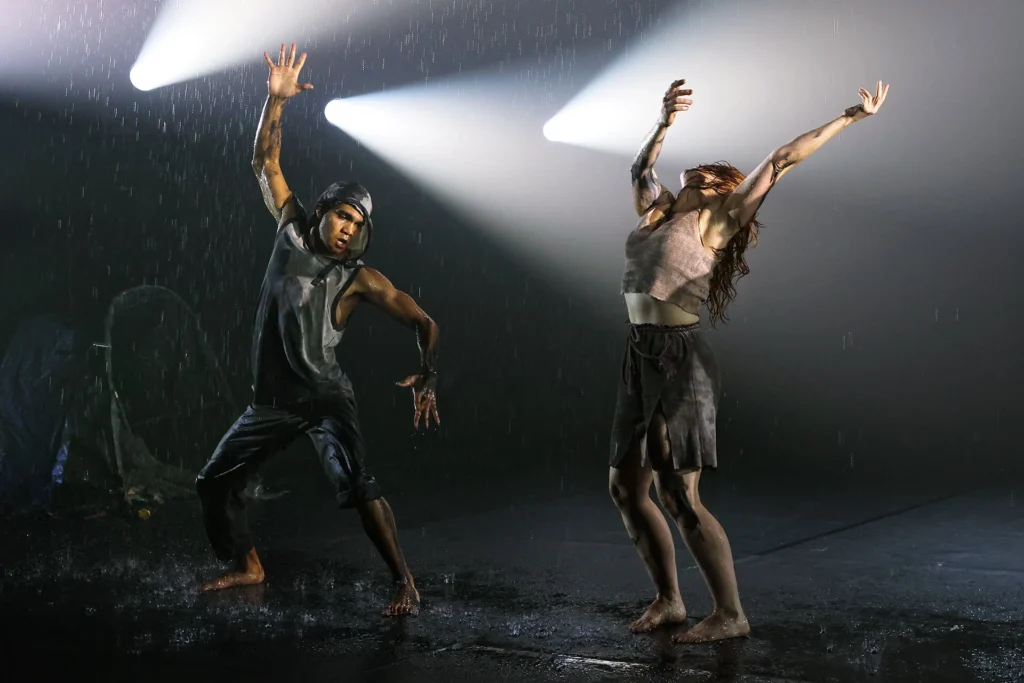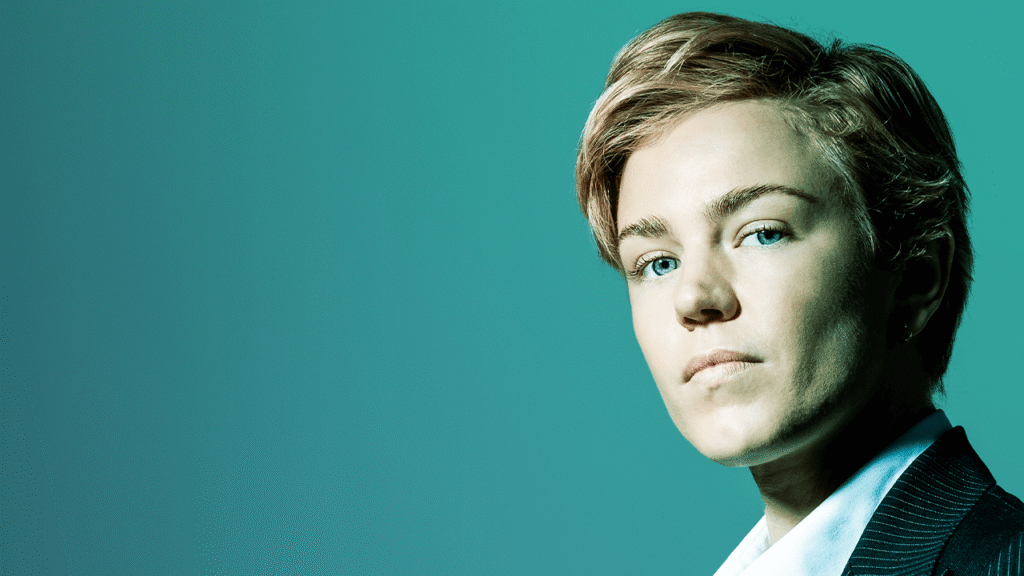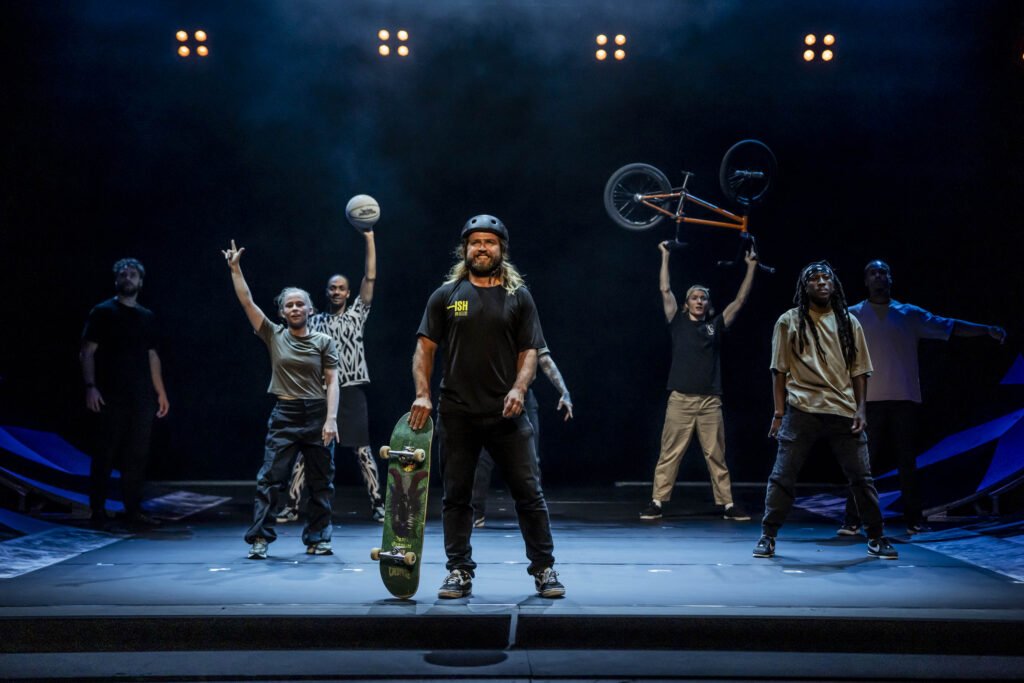Concept by Dalisa Pigram and Rachael Swain with Patrick Dodson. Directed by Rachael Swain
Marrugeku utilise their interdisciplinary artform to meld two of our nations most important issues in a piece that is not an easy watch, but neither are the show’s vital themes
Reviewed by Justin Clarke
Carriageworks, Eveleigh
Until 13th July, 2024
Tickets: https://carriageworks.com.au/events/cut-the-sky-2024/
Blackout. A rush of haze cascades into the space. A slow rhythm hums and drones. White lights slowly rise on an oil drill, pumping minerals offstage. Gasping breaths take over the soundscape as our eyes adjust on the bodies in space, contorting and writhing on their feet, leaning impossibly backwards without falling. Cut the Sky cascades into an interdisciplinary artform reflecting on climate change as the backdrop to explore Indigenous resilience and displacement. The intersection of artforms never lets up, and the final image is one of hope.
Marrugeku, Australia’s leading Indigenous intercultural dance collective “builds bridges and breaks down walls…between Indigenous and non-Indigenous artists and between local and global situations.” Their latest work, Cut the Sky, brings the collective fear of the effects of climate change into the vastness of the Carriageworks space, whilst interspersing the ongoing struggles of displacement and resistance in our First Nations citizens.

Cut the Sky, Marrugeku (2024). Images by Prudence Upton
The concept by Dalisa Pigram and Rachael Swain with Patrick Dodson, utilises contemporary songs, featuring a recognisable tune about paving paradise to put up a parking lot. At the same time, haze pumps out of an oil drill, projecting a hellscape mining hole sitting behind. Swain’s direction is poignant and reflective, not wanting to wow with flashy lights and effects, instead, the confronting nature of the work is somethingly articulated by Pigram and Serge Aimé Coulibaly’s versatile choreography.
Ghostly, evocative vocals, written and recorded by Ngaiire are interspersed to build a sense of disturbance; a warning of what’s to come should those in power fail to act. The vocals and dialogue of Edwin Lee Mulligan’s reflective poems are muffled, whether purposefully or a failure of sound design isn’t clear, but it provides an overall atmosphere of deafness. The warnings we see in the world falling on deaf ears.
Amidst the futility of this built world as a result of climate change, the vocality of displacement is confronted head on.
Stephen Curtis’ costume design features an array of plastics, swishing and crumpling through space on the bodies of the dancers. They fight for warmth and shelter in a world where rain hasn’t come in a generation. The overall dryness of the piece comes through in the thick haze that infiltrates the space from the start, a small scent of burnt wood floating throughout.
Amidst the futility of this built world as a result of climate change, the vocality of displacement is confronted head on. Images of a mob protesting for the protection of their sacred land against drilling stands out in the piece, the politician spouting facts of “friendship” sending tuts and guffaws from audience members. The interdisciplinary artform melds two of the largest ongoing situations we face as a nation, and two that continuously feel as if they are being run in circles.
Cut the Sky is not an easy watch, but neither are the very real world themes which they present.
The ending of Cut the Sky literally cuts a liquid line in space, providing an air of hope and dreams. But with the message of the importance of water being central to the piece, did the onstage trickery make this redundant?
Cut the Sky is not an easy watch, but neither are the very real-world themes which they present. The question becomes how much do we care to do something? How much do you care to walk out of the space and actually do something?
With permission, this performance contains the images of people who have passed away. This performance also contains strobe light, haze and smoke effects.
Cut the Sky is collaboratively created by:
Creative and Cultural team Concept: Dalisa Pigram and Rachael Swain with Patrick Dodson
Director: Rachael Swain
Choreographers: Dalisa Pigram and Serge Aimé Coulibaly
Cultural Dramaturg: Patrick Dodson
Dramaturg: Hildegard de Vuyst
Poems: Edwin Lee Mulligan
Visual concept & Media Artists: Sonal Jain and Mriganka Madhukaillya
Set and Costume Designer: Stephen Curtis
Musical Director: Matthew Fargher
Songwriter & recorded vocals: Ngaiire
Lighting Designer: Damien Cooper
Associate Lighting Director: Kelsey Lee
Cinematographer and video production: Sam James
Rain effect designer: Joey Ruigrok Van Der Werven
Co-devising Performers 2024-25: Samuel Hauturu Beazley, Emmanuel James Brown, Emma Harrison, Dalisa Pigram, Ngaire Pigram, Taj Pigram, Miranda Wheen
Previous co-devising Performers (2015-18) Eric Avery, Josh Mu, Edwin Lee Mulligan
Production
Production Manager and lighting operator: Aiden Brennan
Sound and video production and operation:Declan Barber
Company Stage Manager: Ruben Neman
ProducingProducer: Natalie Smith







